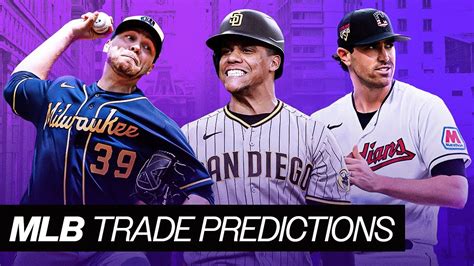
As the MLB trade deadline approaches, several teams face crucial decisions: whether to sell off assets for future prospects or aggressively pursue additions to bolster their postseason chances. This year’s market features a clear divide, with three likely sellers and two potential contenders poised to be buyers, creating a landscape of strategic maneuvering and high stakes gambles.
The Sellers: Acknowledging the Reality
Several teams have underperformed expectations, making them prime candidates to trade away valuable players for prospects. These organizations are focused on the long term, aiming to rebuild and contend in future seasons.
-
Oakland Athletics: The Athletics, mired in a disappointing season, are widely expected to be active sellers. “The A’s, as always, are open for business,” the original article states. Their most valuable trade chip is likely starting pitcher Paul Blackburn, who has showcased his abilities despite the team’s struggles. Other potential trade candidates include veteran infielders and relievers, offering contending teams valuable depth. Oakland’s primary goal will be to acquire young, controllable talent to accelerate their rebuilding process. Expect them to listen to offers on almost any player on their roster with significant trade value.
-
Colorado Rockies: The Rockies, consistently struggling in a competitive NL West, are also likely to sell. Despite some individual bright spots, the team’s overall performance necessitates a strategic shift towards the future. While they may be hesitant to part with established stars, any player that can fetch decent prospects should be on the table, the article implies. The Rockies’ approach is more nuanced due to ownership’s preferences, but the logic of selling remains compelling.
-
Miami Marlins: After a promising start, the Marlins have faltered, making them strong contenders to sell at the deadline. The team has a roster full of talent that can provide a significant boost to contenders. Key players to watch include starting pitcher Jesus Luzardo, who has frontline potential, and utility player Luis Arraez, known for his exceptional contact skills and versatility. The Marlins are in a position to acquire a significant haul of prospects to revamp their roster for future contention. Kim Ng’s departure as general manager adds another layer of complexity, but the need to address roster deficiencies remains clear. The Marlins may also consider moving some of their bullpen pieces, such as Tanner Scott, who have proven track records.
The Buyers: Gearing Up for a Playoff Push
Conversely, several teams are firmly in contention and are actively seeking to improve their rosters for a deep playoff run. These organizations are willing to part with prospects to acquire proven talent, addressing specific needs and solidifying their chances of competing for a World Series title.
-
Los Angeles Dodgers: The Dodgers, perennial contenders, are always looking to add talent. Their focus this year is bolstering their starting rotation. “The Dodgers always look to add pitching,” the original article notes. With injuries and inconsistencies plaguing their current staff, acquiring a reliable starter is a top priority. They have a deep farm system and are willing to part with prospects to secure the necessary upgrades. The Dodgers have also shown interest in adding bullpen depth to handle the late innings in close games. Their aggressive approach reflects their commitment to winning a championship.
-
New York Yankees: The Yankees, driven by their championship aspirations, are expected to be aggressive buyers. Their focus is likely to be on adding offensive firepower and pitching depth. The team has struggled with consistency at times, highlighting the need for reinforcements. The Yankees possess the financial resources and prospect capital to make significant acquisitions. The Yankees will explore all avenues to improve their roster, addressing both immediate needs and long-term depth.
The In-Between: Teams on the Bubble
Several teams occupy a gray area, making their deadline decisions more complex. These teams are close to contention but have vulnerabilities that need to be addressed. They must carefully assess their chances of making a deep playoff run before committing to either buying or selling.
-
San Diego Padres: Despite a talented roster, the Padres have underperformed this season, placing them in a precarious position. They need to decide whether to make a push for the playoffs or re-evaluate their long-term strategy. The Padres’ high payroll adds complexity to their decision-making process. They may consider adding a controllable starting pitcher or a high-leverage reliever. Their deadline strategy will depend on their performance in the weeks leading up to the deadline.
-
Boston Red Sox: The Red Sox are hovering around the playoff picture, making their deadline approach uncertain. They could opt to add a piece or two to improve their chances or sell off some assets if they fall out of contention. Their decision will depend on their evaluation of their team’s long-term prospects. The Red Sox also need to consider their financial flexibility and long-term roster construction.
-
San Francisco Giants: The Giants are in a similar situation to the Red Sox, close to contention but with question marks. They could add a bat or a reliever to improve their chances or sell off some assets if they falter. Their deadline strategy will likely be dictated by their performance in the coming weeks.
Impact of Key Injuries and Performances
Injuries and individual player performances play a crucial role in shaping the trade market. A team that loses a key player to injury may become more aggressive in pursuing replacements, while a player’s breakout performance could increase his trade value significantly.
-
Impact of Injuries: Injuries to key players can drastically alter a team’s trade deadline strategy. For example, a team that loses a starting pitcher to a long-term injury may become desperate to acquire a replacement, driving up the price for available pitchers.
-
Impact of Player Performances: Individual player performances can significantly impact trade values. A player who is having a breakout season may become a hot commodity, while a player who is struggling may see his value plummet.
The Role of Prospect Value
Prospect value is a critical component of trade deadline deals. Teams are often willing to part with established players in exchange for promising prospects, recognizing that these young players could become future stars.
-
Valuation of Prospects: Teams meticulously evaluate prospects based on their potential, performance in the minor leagues, and scouting reports. The value of a prospect is often subjective, leading to disagreements between teams about the fairness of a trade.
-
Impact on Trade Negotiations: Prospect value plays a central role in trade negotiations. Teams often engage in protracted discussions about the value of specific prospects, trying to strike a balance between acquiring immediate talent and building for the future.
The Impact of the New CBA
The new Collective Bargaining Agreement (CBA) has introduced several changes that impact the trade deadline, including restrictions on luxury tax spending and changes to the draft pick compensation system. These changes can affect how teams approach trades and the types of deals they are willing to make.
-
Luxury Tax Implications: Teams that exceed the luxury tax threshold face significant financial penalties. This can discourage some teams from making aggressive trades that would push them over the threshold.
-
Draft Pick Compensation: The new CBA has altered the draft pick compensation system for free agents, making it less costly for teams to sign free agents who have received qualifying offers. This could lead to more activity in the free agent market and less reliance on trades.
Key Players to Watch
Several players are expected to be in high demand leading up to the trade deadline. These players possess the talent and experience to make a significant impact on a contending team.
-
Starting Pitchers: With many teams seeking pitching help, starting pitchers will be in high demand. Potential trade candidates include Paul Blackburn, Jesus Luzardo, and other veteran starters.
-
Relief Pitchers: Contending teams are always looking to bolster their bullpens. High-leverage relievers with proven track records will be highly sought after.
-
Offensive Upgrades: Teams seeking offensive firepower will target players who can provide a boost in the lineup. Potential trade candidates include veteran hitters with power and on-base skills.
The Importance of Team Chemistry
While acquiring talent is essential, teams must also consider the impact of trades on team chemistry. Adding a player who disrupts the clubhouse dynamic can have a detrimental effect on overall performance.
-
Impact on Clubhouse Culture: New players can sometimes disrupt the existing clubhouse culture, leading to friction and decreased performance.
-
Importance of Fit: Teams must carefully evaluate whether a potential trade target will fit in with their existing team chemistry.
Historical Trade Deadline Trends
Analyzing historical trade deadline trends can provide insights into how teams typically behave in specific situations. For example, teams that are close to contention often become more aggressive in pursuing trades, while teams that are out of contention tend to focus on acquiring prospects.
-
Trends in Buyer Behavior: Contending teams typically prioritize acquiring proven talent to improve their chances of winning a championship.
-
Trends in Seller Behavior: Teams that are out of contention typically focus on acquiring young, controllable players who can contribute to future success.
Expert Opinions and Predictions
Various baseball analysts and experts have weighed in on the upcoming trade deadline, offering their opinions and predictions on which teams will be buyers and sellers, and which players will be on the move. These expert perspectives can provide valuable insights into the potential outcomes of the trade deadline.
-
Analyst Perspectives: Baseball analysts offer their perspectives on team needs, potential trade targets, and the overall dynamics of the trade market.
-
Expert Predictions: Experts make predictions about which teams will be active at the trade deadline and which players will be traded.
The Trade Deadline’s Lasting Impact
The trade deadline can have a lasting impact on teams’ fortunes, shaping their playoff chances and long-term prospects. A successful trade can propel a team to a championship, while a failed trade can set a team back for years.
-
Impact on Playoff Races: The trade deadline can significantly alter the playoff landscape, as teams add talent to improve their chances of making the postseason.
-
Impact on Long-Term Prospects: Trades can impact a team’s long-term prospects by adding or subtracting young, controllable players.
Conclusion: A Deadline Full of Possibilities
The MLB trade deadline promises to be a period of intense activity, with teams navigating a complex landscape of needs, valuations, and strategic considerations. As teams weigh their options, the potential for impactful trades remains high, setting the stage for a thrilling conclusion to the season. Teams must carefully assess their current standing, future prospects, and potential acquisitions to maximize their chances of success. The decisions made in the coming weeks will undoubtedly shape the trajectory of numerous franchises.
Frequently Asked Questions (FAQ)
-
Which teams are most likely to be sellers at the MLB trade deadline? The Oakland Athletics, Colorado Rockies, and Miami Marlins are most likely to be sellers. These teams have struggled this season and are expected to trade away valuable players for prospects to rebuild for the future. As the article notes, “The A’s, as always, are open for business,” highlighting their willingness to make deals.
-
Which teams are most likely to be buyers at the MLB trade deadline? The Los Angeles Dodgers and New York Yankees are expected to be aggressive buyers. Both teams are in contention and are looking to add talent to bolster their rosters for a deep playoff run. The Dodgers are focused on pitching, while the Yankees are seeking offensive firepower and pitching depth.
-
What factors determine whether a team will be a buyer or a seller at the trade deadline? Several factors influence a team’s decision to buy or sell, including their current record, playoff chances, financial situation, and the strength of their farm system. Teams that are in contention and have the resources to make additions are more likely to be buyers, while teams that are out of contention and focused on rebuilding are more likely to be sellers.
-
What are some of the key positions that teams will be looking to address at the trade deadline? Pitching, both starting and relief, is expected to be a top priority for many teams at the trade deadline. Teams are also looking to add offensive firepower, particularly players who can provide a boost in the lineup with power and on-base skills.
-
How does the new Collective Bargaining Agreement (CBA) impact trade deadline decisions? The new CBA has introduced changes that impact the trade deadline, including restrictions on luxury tax spending and changes to the draft pick compensation system. These changes can affect how teams approach trades and the types of deals they are willing to make, potentially discouraging some teams from making aggressive trades that would push them over the luxury tax threshold.









